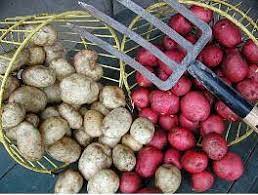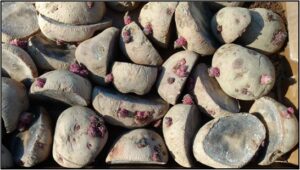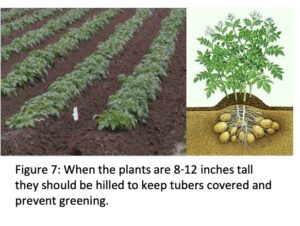Homegrown Potatoes
go.ncsu.edu/readext?919426
en Español / em Português
El inglés es el idioma de control de esta página. En la medida en que haya algún conflicto entre la traducción al inglés y la traducción, el inglés prevalece.
Al hacer clic en el enlace de traducción se activa un servicio de traducción gratuito para convertir la página al español. Al igual que con cualquier traducción por Internet, la conversión no es sensible al contexto y puede que no traduzca el texto en su significado original. NC State Extension no garantiza la exactitud del texto traducido. Por favor, tenga en cuenta que algunas aplicaciones y/o servicios pueden no funcionar como se espera cuando se traducen.
Português
Inglês é o idioma de controle desta página. Na medida que haja algum conflito entre o texto original em Inglês e a tradução, o Inglês prevalece.
Ao clicar no link de tradução, um serviço gratuito de tradução será ativado para converter a página para o Português. Como em qualquer tradução pela internet, a conversão não é sensivel ao contexto e pode não ocorrer a tradução para o significado orginal. O serviço de Extensão da Carolina do Norte (NC State Extension) não garante a exatidão do texto traduzido. Por favor, observe que algumas funções ou serviços podem não funcionar como esperado após a tradução.
English
English is the controlling language of this page. To the extent there is any conflict between the English text and the translation, English controls.
Clicking on the translation link activates a free translation service to convert the page to Spanish. As with any Internet translation, the conversion is not context-sensitive and may not translate the text to its original meaning. NC State Extension does not guarantee the accuracy of the translated text. Please note that some applications and/or services may not function as expected when translated.
Collapse ▲Adapted from Clemson University Potato Publication Potatoes are an easy and fun crop to grow in the home garden and have a historically important place in Pamlico County history. There are many different varieties available for planting that vary in color, shape, size, and texture. From French fries, to potato chips, and almost every conceivable dish in between, potatoes consistently rank number one as the most commonly consumed vegetable in the United States. Let us discuss a few tips to help get your potato crop off to a good start, should you choose to grow potatoes this spring.Plant potatoes between February 15 and March 31 for eastern NC locations. Potatoes are a cool season crop and need to set tubers before warm weather shuts down plants. Try to utilize certified seed potatoes from a garden supplier, when possible, to reduce disease development and to ensure true to type varieties. Potatoes stored from last year or purchased from a grocer can also be used, but they do not perform as well as seed stock and may carry diseases.
Potatoes are an easy and fun crop to grow in the home garden and have a historically important place in Pamlico County history. There are many different varieties available for planting that vary in color, shape, size, and texture. From French fries, to potato chips, and almost every conceivable dish in between, potatoes consistently rank number one as the most commonly consumed vegetable in the United States. Let us discuss a few tips to help get your potato crop off to a good start, should you choose to grow potatoes this spring.Plant potatoes between February 15 and March 31 for eastern NC locations. Potatoes are a cool season crop and need to set tubers before warm weather shuts down plants. Try to utilize certified seed potatoes from a garden supplier, when possible, to reduce disease development and to ensure true to type varieties. Potatoes stored from last year or purchased from a grocer can also be used, but they do not perform as well as seed stock and may carry diseases.
Seed potatoes can be cut in several pieces containing at least one “eye” (actually a bud on the tuber, which is a type of modified stem), weighing at least 2.5 ounces. New stems and roots will form from these eyes as the potato begins to grow. Whole seed potatoes can also be planted, but potatoes forming from these plants will be smaller in size, but more numerous. Commonly available table stock varieties include Dark Red Norland, Harley Blackwell, Kennebec, and Superior. Many additional varieties are available for home gardeners and are worth experimentation to see how they perform in your garden. Newer varieties also include purple and blue fleshed potatoes that add color to the gardening experience.
Plant potatoes in furrows 3 to 5 inches deep, and space seed pieces 8 to 10 inches apart in rows 3 feet apart. Pull a ridge of soil over each row when planting and repeat this process after plants break through the surface. Twelve pounds of seed potatoes should plant 100 feet of row. Utilize a soil test to determine your fertility needs, but in the absence of a soil test use 10-10-10 fertilizer at a rate of 10 pounds per 1,000 sq. ft. at planting. This should be worked into the soil ahead of planting. Follow this application with additional nitrogen fertilizer at a rate of 1 pound nitrogen fertilizer per 1,000 sq. ft. when plants reach 6-8 inches tall. Soil pH values around 6.0 will help to ensure efficient use of soil nutrients, but slightly lower pH ranges between 5.0-5.3 can be useful to control the soil borne disease called scab.
Potatoes average 100 to 120 days to maturity. Harvest potatoes after most of the vines have died; a spade fork is useful for digging. Handle the tubers as gently as possible during harvest to avoid skinning tubers when digging. Leave the tubers exposed to the sun just long enough for the soil to dry and fall off (usually about one to two hours). Potatoes for use in early summer (“new potatoes”) may be dug before the vines die. Dig early potatoes when tubers are large enough to eat. Harvest potatoes for storage about two weeks after the vines die down in midsummer.
Late potatoes are best for winter storage. For six to eight months, potatoes can be stored in medium cool (40 to 50 ºF) moist (90 percent relative humidity) conditions. Sprouting is a problem when stored at higher temperatures.
For more information on growing potatoes, you may contact Daniel Simpson at 252-745-4121 or daniel_simpson@ncsu.edu.





